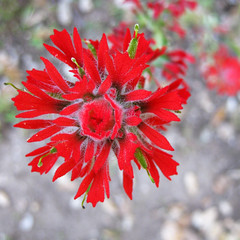
Khadijah, a member of my little on-line writing collective, Red Threads, issued a challenge some weeks back, of posting a piece of writing every day for a month to the group. We settled on October. The piece could be long, short—a single word, if that’s all that came. The point was simply to post something every day.
It’s a bit like the photo-a-day project I’m on round 2 of in Flickr: Project 365. But different. The similarity is in focusing on completing the task each day. And this month, I’ve really been enjoying the double challenge. Though when October is over and the writing-a-day goes away, I probably won’t miss it. But I hope I also don’t lapse into no-writing-ever. It’s funny how I allow myself to be motivated by these “challenges,” where nobody on earth really CARES if I follow through—but I do follow through, punctiliously. (Hm, maybe that means I care. Which usually brings a “so what?” from me—who cares if I care? That, clearly, is something I need to examine. Seriously.)
The difference lies in process. With the writing, I usually just let something spill out. I’m not trying to craft or polish. Whatever comes, is what I post. No editing. Raw material. (And I want to appreciate my Red Threads for letting me do that. And on occasion, responding. You’ve been terrific.)
The photo-a-day typically involves several shots. Today, for example, I started out trying to get a close-up of our cat’s collar (pink with silver crescent moons and stars), against the salt-and-pepper of her fur, because she was handy and it was a nice day to be outside and enjoy the sight of her rolling luxuriantly on the dead pine needles, in the newly greening grass; and for good measure I took a couple of pictures looking down on her with my 100mm lens (which makes for an up-close-and-personal shot). Then I went to the Roost and my neighbor wasn’t home, so I took pictures of her roses, which are glorious at the moment (pink-and-yellow, lavender, deep red, delicate rose, and a yellow bud, just thinking about opening). I also took pictures of Branco, her little white dog (his name means white in Portuguese), who was barking, barking, barking furiously at me. Well, not furious: he just wanted a pat and a scritch. Sometimes he allows me to enter through the high squeaky gate in silence, other times he yips and yips—and I pat him and he's all wagging tail and grateful brown eyes—and then I continue on up the drive, and he launches into yipping again. You’d THINK the pat would calm him down. Maybe he’s a little senile. Though I have no idea how old he is. Might be two, which would rule out senility. Just . . . confused? Doing his job (most of the time)?
Anyway, when I got home, I reviewed the pictures (a pleasant ritual this past year: I’m coming up on day 300, next Tuesday), and the only one—out of twelve—worth posting was one of the kitty as seen from above. I deleted five of the shots outright—erased, gone. The other six . . . okay, five of them are going as well. One of the rose pictures (the delicate-rose rose) I can’t quite bear to part with, since it’s a nice enough shot. Just . . . not worth posting. Or is it? Eh, sure; it’s decent—lovely colors,  pretty good composition; I’ll post it, despite its 1600 ISO graininess (oops: forgot to check again). I need to be more hard-nosed about editing my photos, and anything not worth posting should be launched into oblivion. But I guess I have two categories: pictures-I’m-
pretty good composition; I’ll post it, despite its 1600 ISO graininess (oops: forgot to check again). I need to be more hard-nosed about editing my photos, and anything not worth posting should be launched into oblivion. But I guess I have two categories: pictures-I’m-
It’s similar with writing—except that a thousand raw-material words contain so much more than a picture does, in their formlessness, in their exploration, in their musings and wonderings (and wanderings) and imaginings. A thousand words might well hold five that lead to a provocative essay; or ten, scattered throughout, that generate a poem; or a full sentence that becomes the start of a short story. So I’m thinking of this month’s challenge as a raw-material generator. It’s not journaling, but it is thinking out loud. I’ve identified a few ideas that I might wish to pursue. And I will keep all the words, stick them in a notebook, continue adding to them. When it comes to ideas, imaginings, dreams, self-expression, words are so powerful. Much more so than a straight photograph (which is what I take) could ever be.

.jpg)





